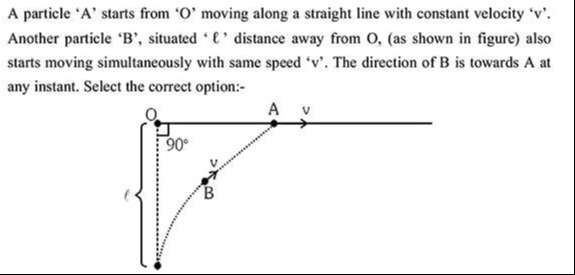Question
Question: A particle 'A' starts from 'O' moving along a straight line with constant velocity 'v'. Another part...
A particle 'A' starts from 'O' moving along a straight line with constant velocity 'v'. Another particle 'B', situated 'ℓ' distance away from O, (as shown in figure) also starts moving simultaneously with same speed 'v'. The direction of B is towards A at any instant. Select the correct option:-

The distance covered by 'B' on y-axis is ℓ/2.
The time for both the particle to meet each other is ℓ/v.
The distance covered by 'B' on x-axis is ℓ.
The distance covered by 'B' on y-axis is ℓ.
The distance covered by 'B' on y-axis is ℓ.
Solution
Let the origin O be at (0,0). Particle A starts from O and moves along the x-axis with velocity vA=vi^. Its position at time t is rA(t)=vti^.
Particle B starts from a point ℓ distance away from O. From the figure, the initial position of B is (0,−ℓ). So, rB(0)=−ℓj^.
Particle B moves with speed v, and its direction is always towards A. Let the position of B at time t be rB(t)=xB(t)i^+yB(t)j^.
The velocity of B is vB(t)=v∣rA(t)−rB(t)∣rA(t)−rB(t).
vB=dtdxBi^+dtdyBj^=v(vt−xB)2+yB2(vt−xB)i^−yBj^.
This gives the differential equations:
dtdxB=v(vt−xB)2+yB2vt−xB
dtdyB=−v(vt−xB)2+yB2yB
with initial conditions xB(0)=0 and yB(0)=−ℓ.
Consider the relative motion of B with respect to A. The relative velocity is vB/A=vB−vA.
The direction of vB is always towards A. So, in the frame of A, the velocity of B always points towards A.
Let's consider the motion in the reference frame of A. In this frame, A is at rest at the origin. The initial position of B in this frame is rB/A(0)=rB(0)−rA(0)=(0,−ℓ)−(0,0)=(0,−ℓ).
The velocity of B in this frame is vB/A=vB−vA.
The direction of vB is towards A.
Let's consider the component of the relative velocity along the line BA.
The rate of change of the distance between A and B, r=∣rA−rB∣, is given by dtdr=∣rA−rB∣(rA−rB)⋅(vA−vB)=r^B→A⋅(vA−vB).
Since vB=vr^B→A, we have dtdr=r^B→A⋅vA−r^B→A⋅(vr^B→A)=r^B→A⋅vA−v.
Let θ be the angle between vA and the line BA. Then r^B→A⋅vA=∣vA∣cosθ=vcosθ.
So, dtdr=vcosθ−v=v(cosθ−1).
Now consider the component of the velocity of B perpendicular to the line joining O and A (the x-axis).
The initial y-coordinate of B is yB(0)=−ℓ.
The y-component of the velocity of B is dtdyB=−v(vt−xB)2+yB2yB.
Let's consider the component of velocity of B along the y-axis.
The initial velocity of B is towards A, and at t=0, A is at O. So, vB(0) is towards O. If B starts at (0,−ℓ), then the initial velocity is along the positive y-axis, vB(0)=vj^.
However, the figure shows the initial position of B at (0,−ℓ) and the direction of B towards A at any instant. At t=0, A is at O(0,0). So the direction of B is towards O. This means the initial velocity of B is along the positive y-axis.
Let's consider the projection of the displacement of B on the initial line OB (the y-axis).
Let y be the y-coordinate of B at time t. Initially y(0)=−ℓ. The initial velocity of B is along the positive y-axis, with magnitude v.
The component of velocity of B along the y-axis is dtdy.
The direction of vB is from B to A.
Let ϕ be the angle between the line BA and the positive x-axis. The vector BA is (vt−xB,−yB).
The angle between vB and the positive y-axis is ϕ−π/2.
dtdyB=vsin(ϕ−π/2)=−vcosϕ.
cosϕ=(vt−xB)2+yB2vt−xB.
dtdyB=−v(vt−xB)2+yB2vt−xB.
Let's consider the component of the velocity of B parallel to the initial line OB (y-axis).
The initial line OB is along the negative y-axis.
The component of vB along the negative y-axis is −dtdyB=−v(vt−xB)2+yB2−yB=v(vt−xB)2+yB2yB.
The initial value of this component is v02+(−ℓ)2−ℓ=vℓ−ℓ=−v.
This is the component along the positive y-axis is v.
The total distance traveled by B along the y-axis is ℓ.
